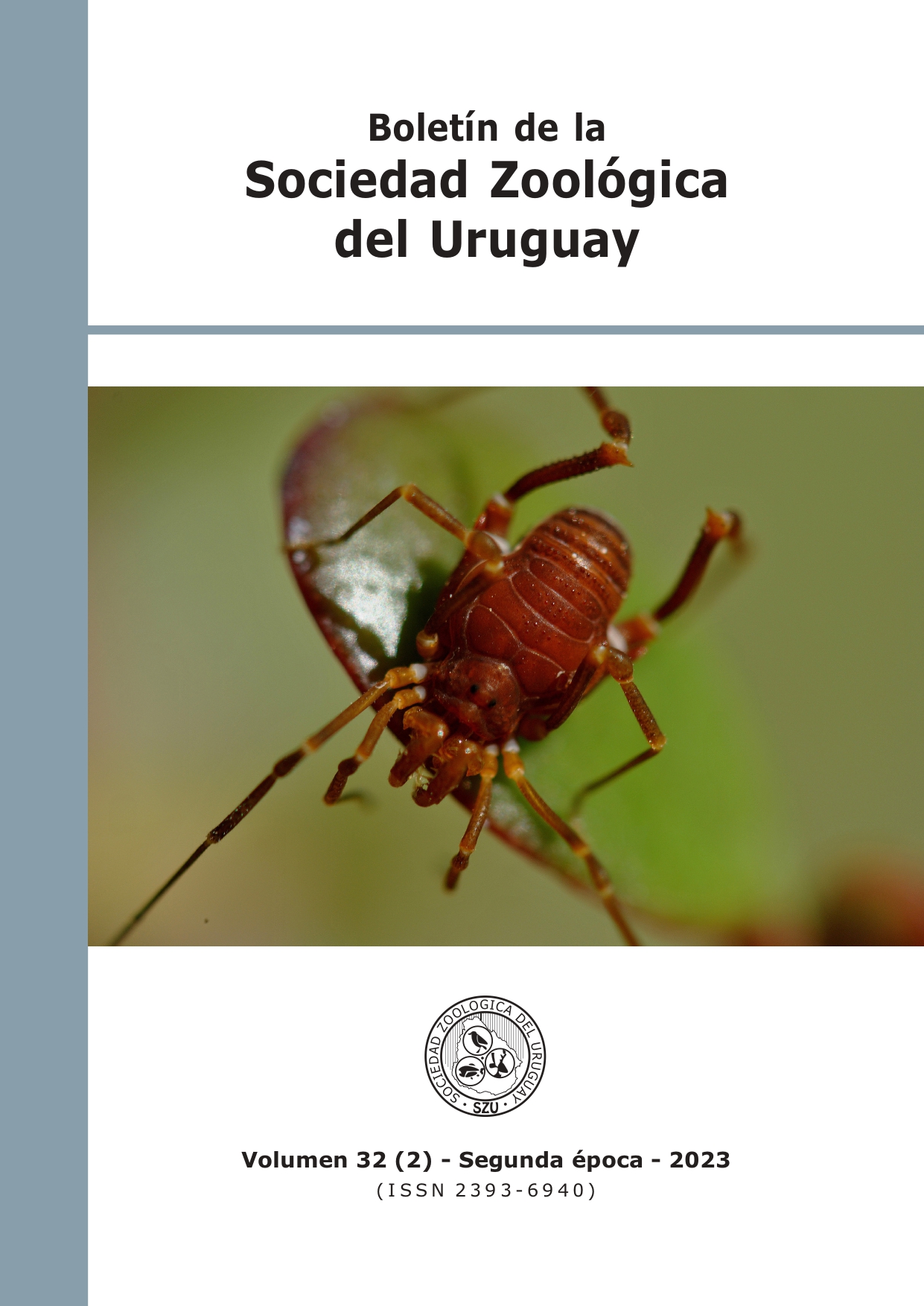INTERACCIONES AGONÍSTICAS ENTRE MACHOS DEL OPILIÓN SOLITARIO Pachyloides thorellii (OPILIONES, GONYLEPTIDAE)
DOI:
https://doi.org/10.26462/32.2.1Palabras clave:
Comportamiento de lucha, peleas entre machos, tamaño corporal, peleas ritualizadasResumen
En especies donde los machos compiten por parejas, se espera que desarrollen comportamientos y/o adaptaciones morfológicas para aumentar su probabilidad de éxito. En el opilión Pachyloides thorellii Holmberg 1878, se han observado enfrentamientos entre machos, aunque no presentan ningún rasgo llamativo de dimorfismo sexual que pueda indicar tal adaptación a la lucha. En este artículo, describimos los encuentros agonísticos entre machos de este pequeño Gonyleptidae solitario y evaluamos si el tamaño corporal relativo influye en la duración y el resultado de la pelea. Las luchas comenzaron con rápidos golpes de las patas II y podían escalar utilizando los tubérculos y espinas de las patas IV, hasta que una o ambas patas quedaban enganchadas. No encontramos relación entre el tamaño corporal de los oponentes y la duración o el resultado de la pelea. Nuestras observaciones sugieren que los encuentros agonísticos en P. thorellii están ritualizados y escalan a través de diferentes niveles de agresividad.
Descargas
Citas
Aisenberg, A., Toscano-Gadea, C.A., y Ghione, S. (2011). Guía de Arácnidos del Uruguay, Ediciones De la Fuga. Montevideo, Uruguay.
Acosta, L. y Machado, G. (2007). Diet and foraging. En: R. Pinto-da-Rocha, G. Machado y G. Giribet (Eds) Harvestmen. The biology of Opiliones (pp.309-338). Cambridge, MA: Harvard University Press.
Andersson, M. (1994). Sexual Selection. Princeton: Princeton University Press.
Blumstein, D.T., Evans, C.S. y Daniel, J.C. (2000). JWatcher, versión 1.0. https://www.jwatcher.ucla.edu/.
Buzatto B.A. y Machado, G. (2008). Resource defense polygyny shifts to female defense polygyny over the course of the reproductive season of a Neotropical harvestman. Behavioral Ecology and Sociobiology, 63: 85–94.
Buzatto, B.A., Macías-Ordoñez, R. y Machado G. (2013). Macroecology of harvestman mating systems. En: R.H. Macedo y G. Machado (Eds.) Sexual selection: perspectives and models from the neotropics (pp. 115-162). Elsevier, Amsterdam.
Buzatto B.A., Tomkins, J.L., Simmons, L.W. y Machado, G. (2014). Correlated evolution of sexual dimorphism and male dimorphism in a clade of Neotropical harvestmen. Evolution, 68(6): 1671-1686.
Caetano D.S. y Machado G. (2013). The ecological tale of Gonyleptidae (Arachnida, Opiliones) evolution: phylogeny of a Neotropical lineage of armoured harvestmen using ecological, behavioural and chemical characters. Cladistics, 1-21.
Capocasale, R.M. y Gudynas, E. (1993). La fauna de opiliones (Arachnida) del criptozoos de Sierra de las Ánimas (Uruguay). Aracnología, 19: 1-15.
Clutton-Brock, T.H. (1982). The function of antlers. Behaviour, 79: 108-121.
Costa, F.G. (2013). Interacciones entre machos de Schizocosa malitiosa (Araneae, Lycosidae) en contextos sexual y no sexual. Boletín de la Sociedad Zoológica del Uruguay (2da. época) 22(2): 66-71.
Crespi, B.J. (1988). Adaptation, compromise, and constraint: the development, morphometrics, and behavioral basis of a fighter-flier polymorphism in male Hoplothrips karnyi (Insecta: Thysanoptera). Behavioral, Ecology and Sociobiology, 23: 93-104.
Cross, F.R., Jackson, R.R., Pollard, S.D. y Walker, M.W. (2007). Cross-modality effects during male-male interactions of jumping spiders. Behavioural Processes, 75: 290-296.
Dias, J.M. y Willemart, R.H. (2016). Do sexually dimorphic glands in the harvestman Gryne perlata (Arachnida: Opiliones) release contact pheromones during mating? European Journal of Entomology, 113: 184-191.
Enquist, M. y Leimar O. (1987). Evolution of fighting behaviour: The effect of variation in resource value. Journal of Theoretical Biology, 127: 187-205.
Fernandes, N.S., Stanley, E., Costa, F.G., Toscano-Gadea, C.A. y Willemart, R.H. (2017). Chemical sex recognition in the harvestman Discocyrtus prospicuus (Arachnida: Opiliones). Acta Ethologica, 20: 215-221.
Fricke, C., Adler, M.I., Brooks, R.C. y Bonduriansky, R. (2015). The complexity of male reproductive success: effects of nutrition, morphology and experience. Behavioral Ecology, 26(2), 617-624.
Geist, V. (1971). Mountain Sheep. Chicago: Chicago University Press.
Hammer, O., Harper, D.A.T., y Ryan, P.D. (2003). Past Palaeontological Software, version 1.18 http://folk.uio.no/ohammer/past.
Kury, A.B. y Pinto-da-Rocha, R. (2007). Taxonomy: Gonyleptidae. En: R. Pinto-da- Rocha, G. Machado y G. Giribet (Eds.) Harvestmen. The biology of Opiliones (pp- 196-203). MA: Harvard University Press.
Machado, G. y Macías-Ordóñez, R. (2007). Reproduction. En: R. Pinto-da-Rocha, G. Machado y G. Giribet (Eds.) Harvestmen. The biology of Opiliones (pp. 414- 454). MA: Harvard University Press.
Mc.Ginley, R.H., Prenter, J. y Taylor, P.W. (2015). Assessment strategies and decision-making in male-male contests of Servaea incana jumping spiders. Animal Behaviour, 101: 89-95.
Mora, G. (1990). Paternal care in a Neotropical harvestman, Zygopachylus albomarginis (Arachnida, Opiliones: Gonyleptidae). Animal Behavior, 39: 582-593.
Neumann, R. y Schneider, J.M. (2015). Differential investment and size-related mating strategies facilitate extreme size variation in contesting male spiders. Animal Behaviour, 101: 107-115.
Parker, G.A. (1974). Assessment strategy and the evolution of fighting behavior. Journal of Theoretical Biology, 47(1): 223-243.
Perrone, L. (2016) Dinámica anual de una población de Opiliones epigeos (Acanthopachylus aculeatus) en un área costera del Río de la Plata. [Tesis de Grado]. Facultad de Ciencias, Universidad de la República, Montevideo.
Proud, D.N. y Felgenhauer, B.E. (2011). Ultrastructure of the sexually dimorphic basitarsal glands of leg I in Manaosbiid harvestmen (Opiliones, Laniatores). Journal of Morphology, 272: 872-882.
Ringuelet, R.A. (1959). Los arácnidos argentinos del orden Opiliones. Revista del Museo Argentino de Ciencias Naturales de Buenos Aires, C. Zool. 5(2), 127-439.
Stanley, E. (2011). Egg hiding in four harvestmen species from Uruguay. Journal of Arachnology, 39: 495-496.
Stanley, E., Francescoli, G. y Toscano-Gadea, C.A. (2016). Mating behavior of the solitary neotropical harvestman Pachyloides thorellii (Arachnida: Opiliones). Journal of Arachnology 44: 210-217.
Silva Fernandes, N. y Willemart, R.H. (2014). Neotropical harvestmen (Arachnida, Opiliones) use sexually dimorphic glands to spread chemicals in the environment. Comptes Rendus Biologies, 338(4): 269-275.
Toscano-Gadea, C.A. y Simó, M. (2004). La fauna de opiliones en un área costera del Río de la Plata (Uruguay). Revista Ibérica de Aracnología, 10: 157-162.
Trivers, R.L. (1972). Parental investment and sexual selection. En: B. Campbell (Ed.) Sexual Selection and the Descent of Man, 1871-1971 (pp. 136-179). Chicago, IL: Aldine.
Wilcox, D., Dove, B., McDavid, D. y Geer, D. (1995) ImageTool. Versión 3.0. Available in: http://compdent.uthscsa.edu/dig/itdesc.html.
Whitehouse, M.E.A. (1997). Experience influence male-male contests in the spider Argirodes antipodiana (Theridiidae: Araneae). Animal Behaviour, 53: 913-923.
Willemart, R.H. y Chelini, M.C. (2007). Experimental demonstration of close-range olfaction and contact in the Brazilian harvestman, Iporangaia pustulosa. Entomologia Experimentalis et Applicata, 123: 73-79.
Willemart, R.H., Farine, J.P., Peretti, A.V. y Gnaspini, P. (2006). Behavioral roles of the sexually dimorphic structures in the male harvestman, Phalangium opilio (Opiliones, Phalangiidae). Canadian Journal of Zoology, 84: 1763-1774.
Willemart, R.H., Osses, F., Chelini, M.C., Macías-Ordóñez, R. y Machado, G. (2009). Sexually dimorphic legs in a Neotropical harvestman (Arachnida, Opiliones): Ornament or weapon? Behavioural Processes, 80: 51-59.
Zatz, C., Werneck, R.M., Macías-Ordóñez, R. y Machado, G. (2011). Alternative mating tactics in dimorphic males of the harvestman Longiperna concolor (Arachnida: Opiliones). Behavioral Ecology and Sociobiology, 69: 995-1005.











